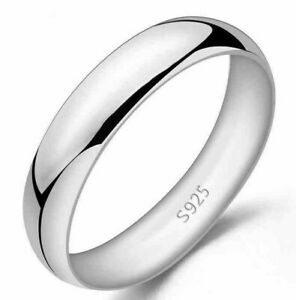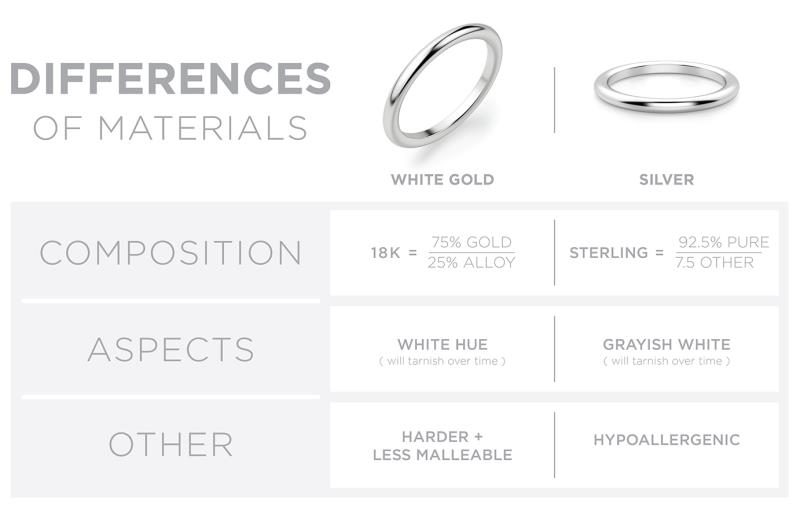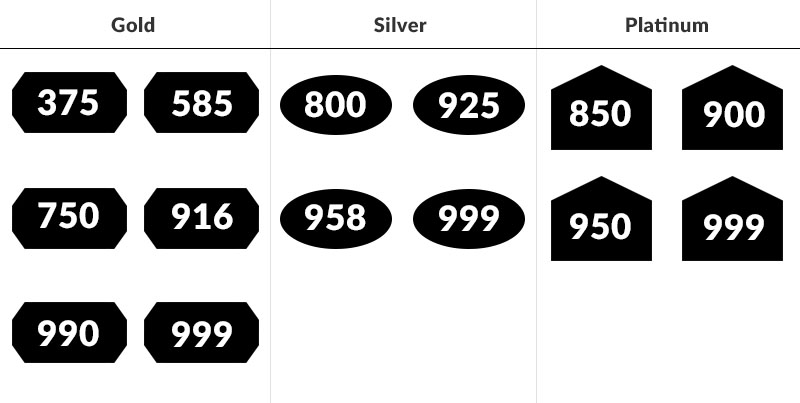Many of us have seen the small numbers or letters engraved inside the ring or near the clasp of the jewelry that we own. But how many of us understand what information those stamps are giving us? 925 stamp is very common and it often appears on various types of jewelry. Let's take a look at what it means.

What does 925 mean on jewelry? Jewelry stamps represent the metal content of the piece. 925 stamp means that this piece of jewelry contains 92.5% of a certain metal. This is really important. For some metal jewelry such as silver-placed and sterling, they are very similar in appearance, and people without professional training can hardly see the difference. Understanding the metal content of your jewelry can help you make sure you get the quality for which you're paying. We often see 925 stamp on silver jewelry and gold jewelry. What are the meanings of these two? The following part will explain it clearly for you.
A piece of jewelry bearing a 925 engraving indicates that the item is 92.5% pure silver. Because silver with high purity is soft and easily oxidized, 925 silver is added with 7.5% of other metals to make it have ideal hardness. 925 sterling silver is the international standard silver for making silver jewelry in the world.
Silver jewelry should generally be marked with the abbreviation of silver ('S' or 'Sterling'). The imprint of standard silver is S925. We can often see s925 stamp on necklaces or rings. After reading the above content, do you know what the s925 ring means? It means that 92.5% of the metal in that ring is sterling silver, the texture is hard, not easy to oxidize, and meets international standards.
Normally, silver is the only metal that should be stamped 925. However, some golden jewelry will also have a 925 stamp, which is a special case, we will introduce it in detail later.
Many people think that a stamp reading “925” on gold jewelry means that the piece contains 92.5% gold. However, this is not true.
925 is not an accepted value for gold purity and has no connection to any common karat numbers used for denoting gold purity. Gold is commonly classified according to karat, with the most popular karat numbers being 18K, 14K, 12K, 10K, and 9K. This states the amount of gold purity in each piece, with 24 being the maximum number of karats. 24K gold is 99.99% pure, meaning it contains no alloyed metals.
If you want to use 925 to represent gold, 925 would be 16.65 K gold, which is not a common purity value for gold. The closest purity grade to ‘925’ gold would be 22 karat which is 91.7%. So there is no 925 gold.
It may seem puzzling why a gold piece would be marked with a stamp commonly used for silver. This is not so surprising, however, and most likely means that the jewelry is not made of solid gold but is actually a silver piece that has been gold plated. In this situation, the 925 stamp makes sense. It denotes the purity of the underlying silver core, not that of the gold plating.

So, if your gold piece is marked with a 925 stamp, what you have is likely gold vermeil. This is the name used to denote silver jewelry covered with a thin layer of gold. Gold vermeil is almost indistinguishable from pure gold jewelry in appearance, so if you want to buy pure gold jewelry, you must distinguish clearly whether there is a 925 stamp. If so, don't buy it.
Let’s return to the topic and continue to discuss some content about 925 silver. White gold and 925 silver are both silvery-white and are loved by many women.
It is difficult to distinguish between white gold and 925 silver with the naked eye. To judge which one is better, you must understand what they are and how they differ. In general, white gold tends to be made of yellow gold and a combination of white metals, such as nickel or palladium. When the two metals are combined they give strength and a mirror-like shine to white gold. The combination of these metals makes white gold more durable and resistant to scratches and corrosion. (Want to buy a real 925 sterling silver necklace?)

As a precious metal, white gold is harder than 925 silver and not easily oxidized, but the price is much higher than that of 925 silver. Since prices are not comparable, we can easily draw conclusions about which one is better. White gold is more suitable to commemorate some important occasions, while 925 silver is a precious metal suitable for daily wear and very cost-effective.
It should be noted that there is no saying that 925 white gold exists in jewelry, so don't be deceived by the merchant.
We can also see some other stamps on gold, silver and platinum. For example, 999 on gold, 999 on silver, 950 on platinum, etc. Don't worry when you see these, here is a table about other stamps. The larger the value, the higher the purity of the metal. But it should be noted that not the higher the value, the better the quality. For example, 925 silver is harder than 999 silver. So it is more suitable for making jewelry. After all, it is better to make the jewelry with the most suitable material.

The above is the definition of 925 stamp on jewelry and the meaning of 925 stamp on different types of jewelry. I hope everyone can brighten their eyes when shopping for jewelry and buy their favorite jewelry.
You may love stunning silver ornaments, but how much do you know about silver? Is silver jewelry made of pure silver? What is sterling 925 silver? And how to identify them? This article will help you know them better.
Read More925 Italy is a common mark that will be seen on jewelry, but what’s the meaning and value? How to identify it? In this article, you will learn more needed information about 925 Italy silver.
Read MoreConfused about the meaning of 14k Italy stamped on jewelry or not sure if the 14k Italy gold is real? Find out everything you need to know.
Read More